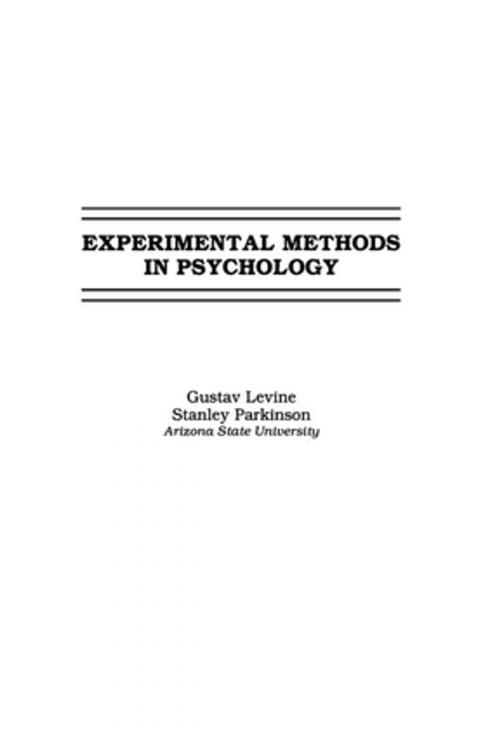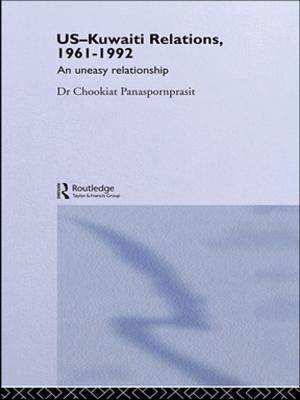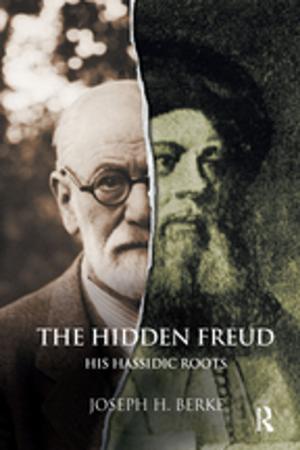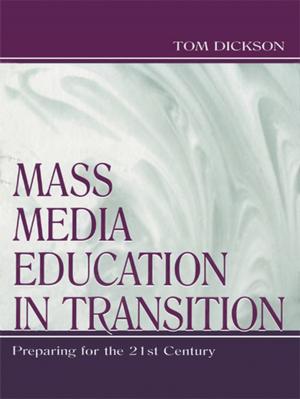Experimental Methods in Psychology
Nonfiction, Health & Well Being, Psychology, Experimental Psychology| Author: | Gustav Levine, Stanley Parkinson | ISBN: | 9781317781035 |
| Publisher: | Taylor and Francis | Publication: | March 5, 2014 |
| Imprint: | Psychology Press | Language: | English |
| Author: | Gustav Levine, Stanley Parkinson |
| ISBN: | 9781317781035 |
| Publisher: | Taylor and Francis |
| Publication: | March 5, 2014 |
| Imprint: | Psychology Press |
| Language: | English |
This text focuses on the experimental methods and the associated terminology encountered in the research literature of psychology. Initially, the content is kept simple, so as not to distract from the information on research technique and philosophy. Interesting psychological questions from well researched areas are then examined in detail, permitting a fuller discussion of the problems encountered in specific paradigms. It is in this fashion that the book offers both methods and content.
Unique features of this text include:
* a detailed discussion of the process of theorizing, coupled with a close examination of psychological constructs, offers the reader an opportunity to see how psychologists think about, develop, and modify their theories, and the part played by research in changing explanations of behavior.
* Although it is common for psychologists to be self-conscious in their reasoning, it is uncommon to see an analysis of the logic that they use to draw conclusions. Presenting material that is rarely verbalized but readily acknowledged by experienced researchers, the text contains an overt analysis of the logic of drawing conclusions from research.
* Instructors are given a choice among 15 chapters to focus on or combine to suit the course's concentration. For example, instructors have the option of focusing on experimental psychology or a broad-based course including material on research methods in experimental, social, clinical, and applied psychology.
* Courses in experimental psychology or research methods are required for every psychology major. Statistical understanding is vital for this curriculum, and this text contains a comprehensive chapter on statistics making it ideal for courses that combine statistics and experimental methods.
Other important coverage includes:
* an all-inclusive summary of the material found in an introductory statistics class. Although courses in research methods and experimental psychology usually have a statistics prerequisite, the students rarely remember the material when entering the research course. This text provides the instructor with the option of simply assigning the statistics information as a review, rather than repeating the lectures. If the course requirements are such as to necessitate a joint statistics and research methods course -- with the instructor lecturing on both topics -- this text could serve as the single text for the course. A helpful discussion -- accompanied by a valuable table -- demonstrates how to choose an appropriate statistic. All necessary formulas and other familiar statistical procedures -- illustrating computational steps -- are also featured.
* a detailed discussion of how to develop tests for use in research. Aside from the value of this information for any researcher, it can be particularly helpful to students who are required to develop original experiments.
* an elaborate discussion of methodological issues in outcome research, using smoking cessation and weight reduction programs as examples.
Test bank disks for Experimental Methods in Psychology, -- free to adopters -- consist of an average of six short-answer, 11 fill-in-the-blank, and 11 multiple-choice questions for each chapter. The files are in both ASCII and Word-for-Windows formats.
This text focuses on the experimental methods and the associated terminology encountered in the research literature of psychology. Initially, the content is kept simple, so as not to distract from the information on research technique and philosophy. Interesting psychological questions from well researched areas are then examined in detail, permitting a fuller discussion of the problems encountered in specific paradigms. It is in this fashion that the book offers both methods and content.
Unique features of this text include:
* a detailed discussion of the process of theorizing, coupled with a close examination of psychological constructs, offers the reader an opportunity to see how psychologists think about, develop, and modify their theories, and the part played by research in changing explanations of behavior.
* Although it is common for psychologists to be self-conscious in their reasoning, it is uncommon to see an analysis of the logic that they use to draw conclusions. Presenting material that is rarely verbalized but readily acknowledged by experienced researchers, the text contains an overt analysis of the logic of drawing conclusions from research.
* Instructors are given a choice among 15 chapters to focus on or combine to suit the course's concentration. For example, instructors have the option of focusing on experimental psychology or a broad-based course including material on research methods in experimental, social, clinical, and applied psychology.
* Courses in experimental psychology or research methods are required for every psychology major. Statistical understanding is vital for this curriculum, and this text contains a comprehensive chapter on statistics making it ideal for courses that combine statistics and experimental methods.
Other important coverage includes:
* an all-inclusive summary of the material found in an introductory statistics class. Although courses in research methods and experimental psychology usually have a statistics prerequisite, the students rarely remember the material when entering the research course. This text provides the instructor with the option of simply assigning the statistics information as a review, rather than repeating the lectures. If the course requirements are such as to necessitate a joint statistics and research methods course -- with the instructor lecturing on both topics -- this text could serve as the single text for the course. A helpful discussion -- accompanied by a valuable table -- demonstrates how to choose an appropriate statistic. All necessary formulas and other familiar statistical procedures -- illustrating computational steps -- are also featured.
* a detailed discussion of how to develop tests for use in research. Aside from the value of this information for any researcher, it can be particularly helpful to students who are required to develop original experiments.
* an elaborate discussion of methodological issues in outcome research, using smoking cessation and weight reduction programs as examples.
Test bank disks for Experimental Methods in Psychology, -- free to adopters -- consist of an average of six short-answer, 11 fill-in-the-blank, and 11 multiple-choice questions for each chapter. The files are in both ASCII and Word-for-Windows formats.















